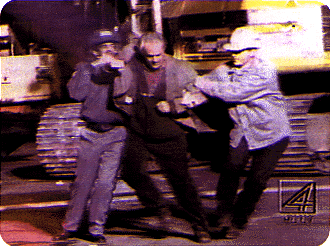
A television news report shows preservationist Jim Howbert being turned back from the J.L. Hudson's site on October 30.
DETROIT–J. L. Hudson's gave up on downtown and locked its doors in 1983, and the big store has stood empty ever since. They boarded up the display windows on Woodward Avenue, where passing crowds once slowed to dream. They stored the gigantic flag that draped across the entire breadth of the building on national holidays. The Christmas fantasies of three generations of Detroiters were crated and sealed.
Opened in 1911, Hudson's was among the largest department stores in America when it reached full size n 1946, 2.2 million square feet to be exact. After the store was shuttered, there was no shortage of plans for it: offices, loft apartments, boutique shopping. But with the building's interior gutted and bright visions of renewal bobbing across downtown, the city decided last year that the only option for Hudson's was demolition.
"Everybody loves the old Hudson's. I love it too," Mayor Dennis Archer told a local newspaper. "But you can't stand in the way of progress."
In November, a Wayne County Circuit Court judge agreed, removing a restraining order obtained by an ad hoc group of preservations who insisted more public hearings be held before city money was used to tear down Hudson's. The building is scheduled for demolition in February.
"This fight was unwinnable," says Michael Matts of the Midwest Regional Office of the National Trust. A native Detroiter, Matts had worked hard to preserve the building. "If there had been a willingness to save it by any part of the city's economic structure, it could have been saved. I have a file three feet thick. But this is a time of tremendous change in Detroit. We can't marginalize ourselves. If we want to be part of the effort to preserve more historic structures in the area, we have to pick our battles. There are several others we feel we can win."
After years of decline, the city's central business district is about to be transformed. Since Hudson's closed, downtown retail activity has dried up. Business have moved out steadily. A wealth of structures built in the first years of Detroit's automotive boom were abandoned. Among them were such civic landmarks as the Book-Cadillac Hotel and the Michigan Central Station.
Now the entire northern half of the city's downtown will be given over to adjoining baseball and football stadiums and three gambling casinos. (A few blocks away, Tiger Stadium home of the city's baseball team since 1901, will be deserted, its future unclear.)
But in plans drawn up in the Detroit Downtown Development Authority, a quasi-public body involved in reordering downtown, loft apartments will be included in rehabilitations of many older buildings in the area between the Hudson's site and the new stadiums. This has been designated the Necklace District, because the narrow streets in the 20-block area run in arclike strands as they cross Woodward. The first lofts opened this year in the former Wright-Key building, a Michigan historic landmark. Planners are hopeful that expanded residential opportunities in the Necklace will return some luster to the retail and street life of the dormant downtown.
Is the business community connecting preservation with economic development? Attorney Tom Curren, a tax specialist with several owners of older buildings as clients, notes that "two years ago my load was about 70 percent low-income tax credits and 30 percent historic credits. Today, that's reversed."
A big problem in Detroit is that preservation efforts tend to take on racial overtones. There was little sentiment for saving Hudson's among the African-American politicians and business people who control the city, for example. The store was remembered, instead, for the many years in African-Americans were not allowed to work in sales and were relegated to operating elevators. But a few black activists joined the effort, and there will be expanded efforts to involved more African-Americans in planning the Necklace District. "I think attitudes are changing," says Jim Turner, an African-American and president of Preservation Wayne, one of the groups most active in the Hudson's fight. "I've developed a program that goes into the schools and shows how this is part of the history of their city. If we place preservation framework of family and neighborhood, and not just sentimentality, we can engage black interest."
Local developers have announced that a $100-million office
tower and retail structure will occupy part of the Hudson's site.
"There are firm plans in place," says Larry Marantette,
president of the Downtown Development Authority. "That's why
we just can't wait any longer before tearing it down." That
project will also include the Kern block to the south, where
another department store was torn down in the early 1960s and not
replaced by anything.
